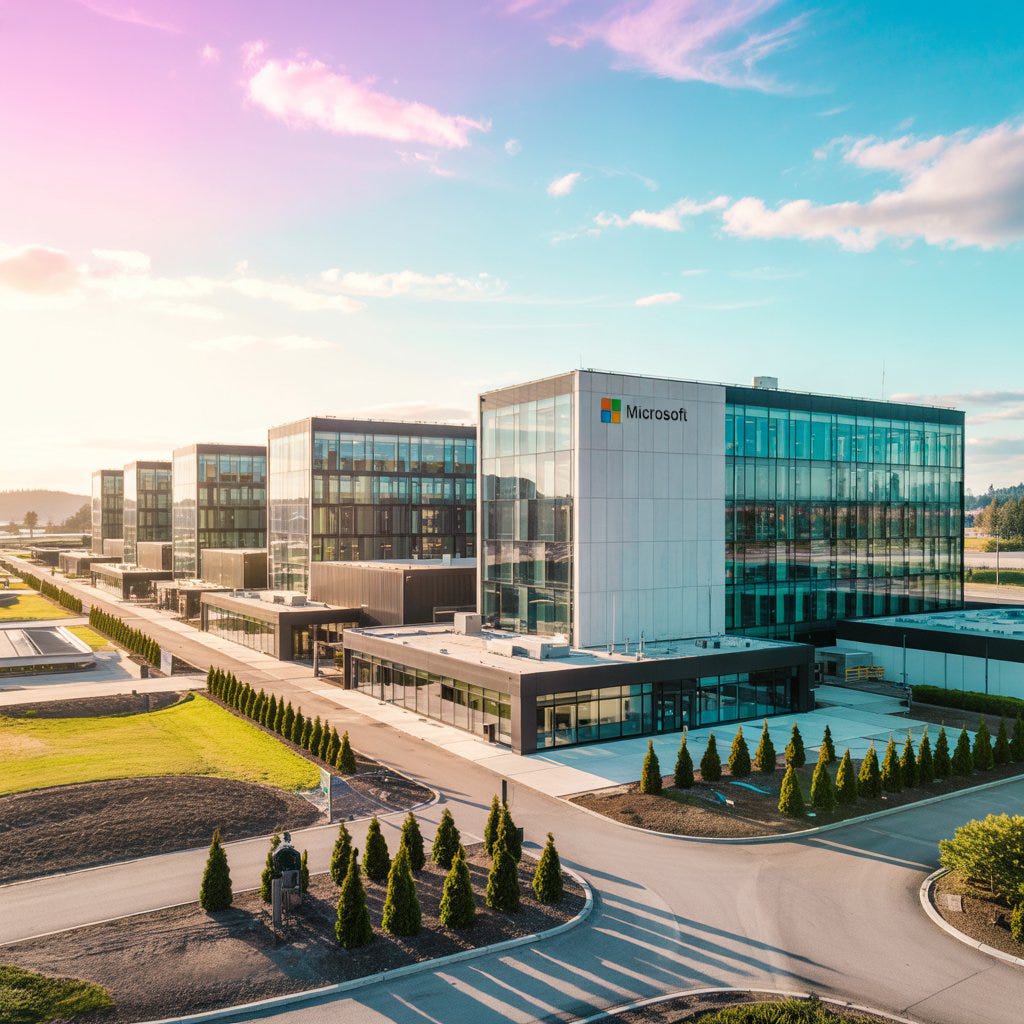Microsoft’s $4 Trillion Playbook: How AI Infrastructure Strategy is Rewriting the Global Data Center Map
Record earnings fuel record capex as Microsoft accelerates AI-first data center builds, locking in land, power, and sovereign cloud footholds across Southeast Asia, India, the Middle East, and beyond.
Welcome to Global Data Center Hub. Join investors, operators, and innovators reading to stay ahead of the latest trends in the data center sector in developed and emerging markets globally.
Microsoft ended FY2025 not only with record earnings but with a clear signal.
The battle for AI leadership will be won on infrastructure depth, capital velocity, and market reach.
The company’s Q4 numbers $76.4B in revenue (+18% YoY), $3.65 EPS (+24% YoY), and a $4T market cap milestone were headline-grabbing.
But behind the financial performance lies a capital allocation and site selection strategy that is reshaping where and how hyperscale capacity comes online.
The story is no longer about adding incremental racks in mature markets.
It’s about building multi-gigawatt, AI-first campuses tied to GPU supply, custom chip ecosystems, sovereign cloud offerings, and power-secure sites in the US across various developing markets.
For investors and operators, Microsoft’s approach offers both a benchmark and a warning.
Future AI infrastructure leadership will demand the ability to execute multi-region builds at hyperscale, underpinned by long-term energy and land commitments.
Earnings & Infrastructure Strategy
Financial Performance
Q4 FY2025 Revenue: $76.4B (+18% YoY), vs. $73.86B consensus.
EPS: $3.65 (+24% YoY), 8% beat over estimates.
Microsoft Cloud Revenue: $46.7B (+27% YoY), with Azure alone surpassing $75B annual revenue (+34% YoY).
Free Cash Flow: $37.2B in Q4, $71.6B for the year (+26% YoY).
CapEx Trends
Q1 FY2026 capex is projected at $30B Microsoft’s highest quarterly investment to date.
FY2025 capex totaled $64.6B (+45% YoY), heavily weighted toward AI infrastructure buildouts.
Management confirmed these spends are tied to $368B in contracted backlog, reducing risk of underutilization.
Infrastructure Stack
GPU & Custom Silicon: Azure AI regions are designed for liquid-cooled NVIDIA GPUs and emerging custom accelerators, giving Microsoft flexibility against supply volatility.
Sovereign Cloud: Expansion of the Microsoft Sovereign Cloud model to high-regulation markets allows public sector and regulated industry adoption without cross-border data concerns.
Global AI-First Regions: Over 400 data centers in 70+ regions, each AI-ready with power and cooling optimized for large language model training and inferencing workloads.
Emerging Market Expansion
Microsoft’s expansion strategy now explicitly prioritizes emerging markets with a blend of greenfield builds, joint ventures, and sovereign partnerships:
Southeast Asia
Malaysia: $2.2B investment in three hyperscale sites in Johor and Greater Kuala Lumpur, leveraging proximity to Singapore’s demand hubs. Recent land acquisition (~91,000 m²) in Johor signals multi-phase build intent.
Indonesia: $1.7B AI/cloud investment aligned with the Golden Indonesia 2045 vision, with potential locations near Nusantara, the new capital, to anchor public sector workloads.
India
Telangana: $3.7B commitment for 660 MW of capacity one of Microsoft’s largest outside the U.S. positioning the state as a major AI compute hub.
Partnership with Yotta: Integration of Azure AI into India’s sovereign AI cloud platform “Shakti,” providing compliance-ready AI infrastructure for government and regulated sectors.
Middle East & Africa
UAE: $1.5B investment in AI firm G42 and co-development of a sovereign cloud on Khazna’s infrastructure.
Saudi Arabia: Three Azure availability zones completed in Eastern Province, with services slated for 2026 enabling oil-to-AI diversification in Vision 2030 strategy.
Latin America
Brazil: While not yet a public hyperscale campus announcement, Microsoft is in advanced stages of site evaluations tied to sovereign cloud and renewable PPAs, signaling intent to anchor a LATAM AI region within two years.
Energy Supply, Land, and Partnerships
Energy Security: MGX alliance (with Temasek and BlackRock) embeds renewable power procurement into multi-region build planning. Several EM campuses will be co-located with solar or wind generation to mitigate grid instability risks.
Land Bank Strategy: Large, pre-zoned industrial parcels acquired in Johor and Telangana reduce permitting delays and provide headroom for multi-phase buildouts.
Local Partnerships: Critical alliances G42 (UAE), Yotta (India), Temasek (Asia) deliver regulatory clearance, local talent pipelines, and political capital.
Signals of Strategic Prioritization
GPU Allocation Drives Geography: Markets where GPU and power availability can be secured ahead of demand are prioritized, even if current enterprise demand is modest.
Sovereign Cloud Readiness: Early deployment in high-regulation regions ensures first-mover advantage in public sector AI adoption.
Energy & Land as Gatekeepers: Every targeted EM market has a parallel energy strategy and long-term land holdings indicating Microsoft views these as the primary constraints to AI infrastructure scaling.
Strategic Close
Microsoft’s FY2025 close makes two things clear:
The company is no longer in a “follow-demand” mode in emerging markets it is building ahead of the curve where it sees regulatory tailwinds, energy security, and long-term AI demand convergence.
The capital intensity is staggering, but the investment model is disciplined: hyperscale builds tied to contracted backlog, diversified workload demand, and ecosystem lock-in via productivity and developer tools.
Investor Takeaway: Microsoft’s EM data center strategy is a moat in the making — not just because of scale, but because it interlocks infrastructure, compliance, and application ecosystems in ways that will be difficult for competitors to replicate.
Operator Takeaway: This is a blueprint for de-risked hyperscale expansion: align capacity with signed demand, lock in energy early, and use sovereign cloud positioning to secure public sector and regulated workloads before rivals.

